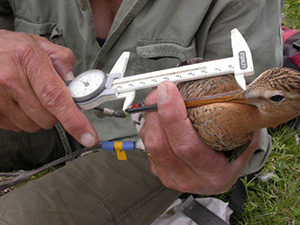Grutto's blijken echte hoogvliegers
Onze nationale vogel, de grutto, vliegt tijdens zijn trektocht naar en van de West-Afrikaanse overwinteringebieden voor meer dan 20% van de tijd op grote hoogte. Dat wil zeggen op ca. vijf kilometer; soms vliegen de grutto’s zelfs op hoogtes van bijna zes kilometer. Dit blijkt uit een nieuwe studie, deze week gepubliceerd in de Royal Society Journal Proceedings B, van onderzoeker dr. Nathan Senner van de Rijksuniversiteit Groningen / University of Montana en zijn team. De uitkomst wekt verbazing, want grutto’s zijn echte laaglandvogels. Deze zouden de fysiologische aanpassingen, met name van de rode bloedcellen, ontberen om te vliegen op hoogtes waar de partiële druk van zuurstof minder dan 50% van die op zeeniveau is. Alleen de ganzen die over de Himalaya trekken zouden dit aankunnen.
In de opmerkelijke studie gebruikten post-doctoraal onderzoeker Nathan Senner (Piersma-group) en mede-onderzoekers van de RUG en UvA, GPS-trackers om de vlieghoogtes en vleugelslagfrequenties van trekkende grutto’s te meten. Deze gegevens werden gecombineerd met informatie over wind, temperatuur en luchtdruk. Afgezien van de opvallend lange tijd die grutto’s op grote hoogtes vlogen, viel het op dat ze dat deden in afwezigheid van topografische barrières zoals bergen. De zeer hoge vlieghoogtes kunnen te maken hebben met het vermijden van hoge luchttemperaturen op lagere hoogten. De grutto’s ondervonden er vaak ook iets meer meewind.

Topsporters
Nathan Senner: “Bijna 20% van alle vogelsoorten migreert jaarlijks over lange afstanden tussen hun broedgebieden en overwinteringsgebieden. Deze trektochten of 'flyways' vertegenwoordigen legendarische sportprestaties. Het gaat om prestaties die onze ideeën over de limieten aan uithoudingsvermogen en fysiologie op hun kop hebben gezet. Dat geldt voor de non-stop vlucht van rosse grutto’s over de Stille Zuidzee; 11-12 duizend kilometer non-stop van Alaska naar Nieuw-Zeeland. En dat geldt voor de trekvluchten van ganzen over de Himalaya. Maar onze eigen grutto’s bleken nog meer verassingen in petto te hebben en zijn dus eigenlijk topsporters!”
Door deze onderzoeksresultaten moeten trekvogelbiologen hun algemene opvatting over hoogvliegen herzien. Laaglandvogels hebben grotere capaciteiten om (zeer) hoog te vliegen dan ze voor mogelijk hielden. En vluchten op grote en zeer grote hoogte zijn waarschijnlijk veel minder zeldzaam dan we altijd hebben gedacht.
Meer nieuws
-
11 december 2025
Stormachtige planeten en een onverwachtse atmosfeer
-
09 december 2025
RUG-hoogleraar bij COP30: ‘Het is altijd drama’
